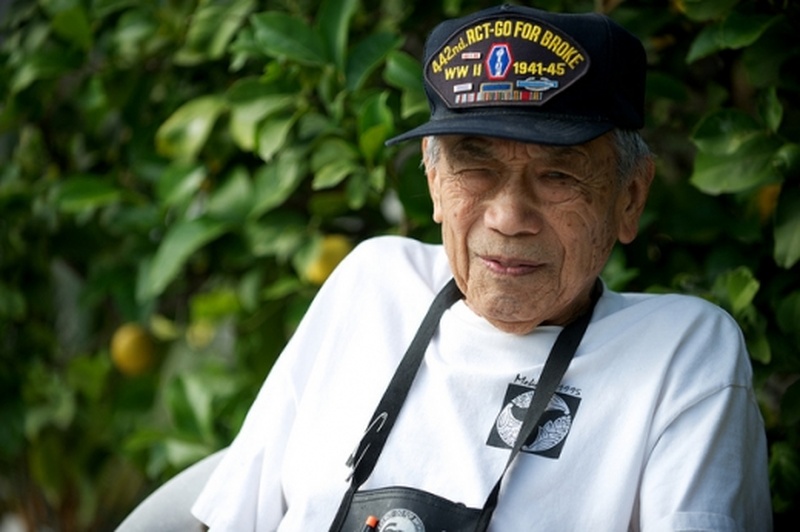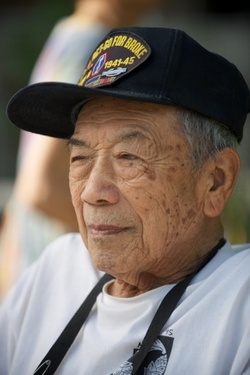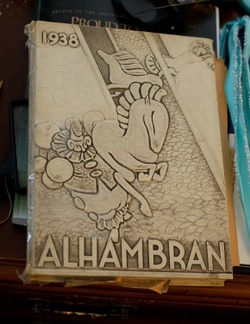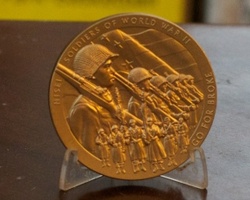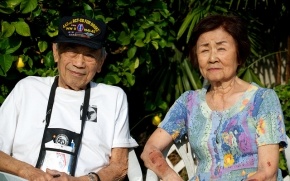Jimmy Makino sat in an internment camp in mid-1940s Arizona. Among a room of other Japanese Americans at the Gila River Relocation Center, the Alhambra High School graduate in his early 20s raised his hand.
“I’m outta here,” Makino said.
A man from the War Relocation Authority looked at Makino with surprise. “You’re stuck with us in these camps,” he said.
“I’m leaving here,” Makino said. “I’m volunteering for the army of the United States of America.’”
This is how Makino, now 92, begins the story of how he joined the famed 442nd Regimental Combat Team, the most decorated fighting unit for its size and length of service in the history of the U.S. Military, according to Go For Broke. The World War II unit was composed entirely of Japanese Americans, and they fought with the motto “Go For Broke,” a gambling term for risking it all. Sitting in the living room of his San Gabriel home surrounded by medals, black and white photos, and old Alhambra High yearbooks, the retired telephone company worker tells me he’s one of the last living members of the 442nd in the San Gabriel Valley.
Makino was born in 1921 in Los Angeles and lived in San Gabriel with his parents and three older sisters. His parents left Japan years before he was born for better economic opportunities. “This was the place to come to, the United States of America,” Makino says.
He attended Alhambra High School, playing on the junior varsity football team—then called Team B—and enjoying woodshop class. Makino even remembers building a red cedar chest so well crafted that his football coach commissioned him to build a pair of skis.
But the family’s plans changed in 1942. In a move it claimed protected national security after the attack on Pearl Harbor, the government ordered Americans of Japanese descent in parts of the western United States be sent to internment camps. Makino was one of the 120,000 Japanese Americans forced to leave their homes.
“The War Relocation Authority were the big guns and whatever they said goes,” Makino says. “There was a reading of what would happen to us and that’s exactly the way it went.”
Makino’s football, a gift from one of the coaches at Alhambra High School, was the only item he brought with him to the relocation center. Around 20 years old, Makino entered the camp in Arizona with his parents. His sisters were married, so each of them moved with their husband into a separate family unit within the camp.
Conditions in the camp were sparse. Showers were in one big room with 10 showerheads. The restrooms were separated, male and female, but with no partitions in between the toilets. Residents were given three meals a day.
“Whatever they had in the kitchen, whatever the cooks could make, they did the best they could,” Makino says. “That’s what they fed us and that’s what we survived on.”
Looking to make money and fill time, Makino soon found a job in the post office that paid 17 dollars a month.
“Daily, it was up to you to occupy yourself into something you wanted to do,” Makino says. “We were going nowhere and that was an all-day job.”
Soon Makino was so desperate to leave the internment camp that he was willing to fight for the government who put him there.
“That was my way of getting out,” Makino said. He enlisted in the U.S. Army and was sent to Camp Shelby in Mississippi to train with other members of the 442nd.
Makino found the transition from internment camp to military training camp an easy one. He met other Japanese Americans in the 442nd, many originally from Hawaii. While Makino didn’t find much discrimination against Japanese Americans in the camps, he did see stark black and white segregation.
“This is one of the first things that hit in me the face. Oh boy, I got to go to the bathroom. Where do I go? Black or white?” Makino says. “Of course we didn’t go to the black, so we went to the white bathrooms.”
Soon Makino was fighting in the war, traveling with the 442nd to Europe and North Africa. Awarded a high distinction along with a number of military decorations, the 442nd became fondly known as the Purple Heart Battalion, a nickname that stemmed from their unit receiving over 4,000 purple hearts. Makino also received a bronze star and combat infantry badge for his bravery after a leg injury in Italy.
“They were throwing mortars and they threw a big rock and I was like, ‘Oh my gosh.’ This rock was as big as a Volkswagen,” Makino says. “And here comes the mortar shells, one hit me on the right lower leg and I thought to myself, ‘It’s warm. Gosh, warm, what warm, how can that be?’ It was my own blood running down my calf into my shoe.”
Makino returned to San Gabriel after the war ended in 1945 and got married two years later. He and his wife Masayo, parents to daughter Holly, have lived in the city for over 60 years. These days, Makino volunteers with the Japanese American National Museum in Los Angeles to keep his story alive, especially with younger generations.
“All of this is a part of history. That’s what it is. I’m a part of it,” Makino says. “If any of what we’re talking about gets written down in paper form and if they get to read it, I hope they understand.”
*This article was originally published on Alhambra Source on July 18, 2013.
© 2013 Connie K. Ho


